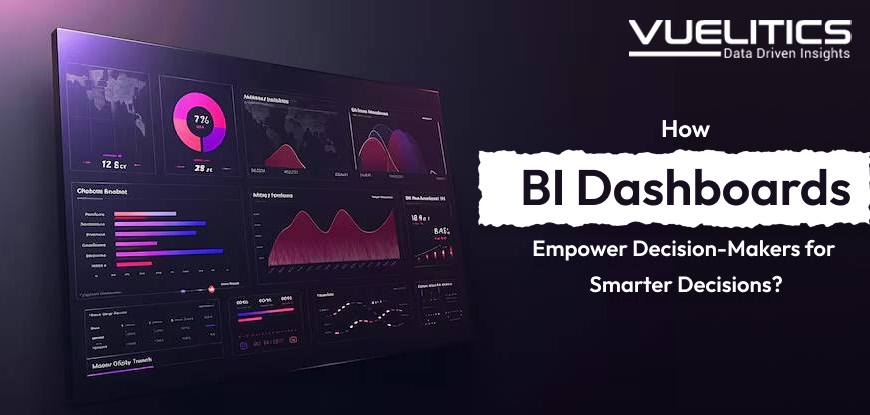- Home
- Blogs

How BI Dashboards Empower Decision-Makers For Smarter Decisions?
In the competitive business landscape of today, businesses are relying more and more on their BI dashboards to help them get the most out of their data. As a result, business intelligence dashboards have become an essential resource for modern-day leaders of all stripes. Be it an executive keeping track of company-wide KPIs or a manager monitoring the performance of a team, dashboards make bulky data more manageable as easy-to-digest visuals, which can be used for making informed decisions.
This blog discusses the role of BI dashboards in empowering decision-makers, showcasing their key benefits and explaining why they’re essential tools for making smarter, data-driven decisions. To fully leverage their potential, many organizations turn to Business Intelligence and Data Analytics Services that provide the tools and expertise needed to implement and optimize these dashboards effectively.
Understanding BI Dashboards
A BI dashboard is a digital display that communicates business data visually. Rather than wade through dozens of reports or spreadsheets, executives now look to interactive BI dashboards to attain a 360-degree view of the performance metrics.
Example types of business analytics dashboards include:
- Executive dashboards are designed for upper management to monitor company-wide KPIs.
- Real-time analytics dashboards follow real-time snippets like sales, supply chain performance, or customer service metrics.
- Executives’ KPI Dashboards—Target one goal, such as revenue, churn rate, or market share.
By providing customizable layouts and drill-down functionality, customizable BI dashboards better allow decision-makers to include insights into the broader context of an organization.
Why BI Dashboards Are So Important for Intelligent Decision-Making?
Consolidation of Data Sources
Businesses today run on many platforms: CRMs, ERPs, financial systems, and marketing analytics. These sources are mashed up through a business intelligence dashboard and delivered as a single view. This consolidation rids the organization of silos and enables leaders to base decisions on complete, accurate data.
Real-Time Insights
Timing is critical in all fast-moving industries. Real-time analytics dashboards keep leaders informed throughout the day so they can react promptly to market or customer or company inefficiencies. For instance, sales managers can see falling conversions and tweak strategies before losses start piling up.
Enhanced Data Visualization
Complex data often overwhelms decision-makers. BI dashboards convert figures into visual formats—graphs and charts, heatmaps—so that it’s simple for us to spot patterns or trends. This visual representation makes it possible for the non-technical team of an organization to make decisions using a BI tool.
KPI Monitoring
Executive dashboards that continuously display organizational objectives. From financial performance to customer satisfaction, these dashboards monitor the metrics that count. By bringing attention to progress and potential risks, executives can make proactive adjustments.
Explorative Interactive Features
BI dashboards are basically different from traditional reports, which are unchangeable. They enable user interaction through facilities such as drill-down to identify the exact data points. For instance, the chief financial officer can start with a revenue overview and drill down to sales rep, location, or product category. This level of flexibility and nature of prompting ensures that leaders are challenged to move from superficial insights towards root-cause analysis.
Advantages of BI Dashboards in Business Decisions
- Quicker Decisions: Comma-separated values, leaders don’t have to wait for monthly reports to see data.
- Higher Accountability: When departments and leaders all look at the same KPIs, accountability increases throughout the company.
- Better Forecasting Historical and real-time data in systems like business analytics dashboards, which provide decision makers with a consistent view of data as well as insights into the latest trends, enable leaders to anticipate the future.
- Strategy Alignment: When metrics are connected to objectives, decisions will be in line with the overall business strategy.
- Cost and resource effectiveness: With automated reporting through BI dashboards, manual effort is minimized, allowing resources to focus on more strategic activities.
Key BI Dashboard Features for Decision Makers
The following are capabilities to consider when assessing BI dashboard features made for decision makers:
- Customization: Each business is different and offers its own set of challenges, which is why customizable BI dashboards let users customize their visuals and KPIs to match what they are responsible for.
- Mobility: Executives are frequently in transit, so mobile-maneuverable dashboards guarantee insights at their fingertips.
- Data Drill-Down: The ability to view aggregate information and then “drill down” to detailed data representations.
- Collaboration Tools: Sharing learnings among teams promotes cross-functional decision-making.
- Alerts & Notifications: Automated and real-time alerts give leaders the ability to take action on anomalies or emergent trends on the fly.
BI Dashboard Best Practices
To gain the most from your BI dashboard, follow these best practices:
- Find the Right Metrics: All data points are not created equal. Concentrate on KPIs that are fully linked to strategic aims.
- Minimize Design: Keep It Simple, Do not clutter up. The design is clean and simple, making dashboards easy to understand.
- Standardize Visuals: Using the same colors, charts, and layouts will help avoid confusion and enable prompt action.
- Quality of Data: Dashboards are only as good as their inputs. Frequent audits and integration tests must be executed at regular intervals.
- Encourage User Training: The most useful executive dashboards in the world need training to drive adoption.
- Iterate and refine: Dashboards should be updated as things change, because business priorities are constantly shifting.
Real-World Examples of BI Dashboards Driving Smarter Decisions
- Retail: Merchants utilize real-time analytics dashboards to track sales by area, manage inventory, and dynamically modify promotions.
- Healthcare: Hospitals use interactive BI dashboards to monitor patient results, employee productivity, and operational performance.
- Finance: CFOs rely on KPI dashboards for executives to monitor revenue, costs, and profitability in real time.
- Manufacturing: Business analytics dashboards help operations managers minimize downtime, track the supply chain, and enhance production efficiency.
In all these scenarios, dashboards help to leverage the data for the organization, which saves time for the decision-makers and qualifies the decisions taken.
The Future of BI Dashboards
The future of business intelligence dashboards is in the combination of AI and predictive analytics. A new generation of executive dashboards won’t just show what happened but will also forecast what’s likely to happen and recommend the best actions. Also, through natural language queries, executives will be able to talk with dashboards; thus, BI interaction will be simpler and quicker for decision-makers to use.
Conclusion
At a time when data is the lifeblood of a competitive edge, BI dashboards are an essential tool that facilitates better decision-making. Through the provision of dynamic insights, customizable functionality, and interactive navigation, they enable senior executives and managers to make decisions with confidence.
By following best practice BI dashboard design principles at every stage: selecting the right metrics, cleaning up data messes, and beyond, organizations can ensure that their BI dashboards contribute to achieving better business decisions. From tracking KPIs to predicting trends to mapping strategies with tactics, dashboards are changing the way companies get things done.
In short, business intelligence dashboards are no longer a nice-to-have tool; they’re critical for companies interested in survival in a data-driven world.
Frequently Asked Questions
What is a BI dashboard?
A BI dashboard is an online platform that visualizes business data in a rich and interactive way. It facilitates decision-makers to monitor KPIs and track performance or take decisions based on data.
How is decision-making facilitated by BI dashboards?
Business intelligence dashboards aggregate information from diverse sources, generate immediate insights, and make available relatively complex arrangements of data using a visual format, which is clearer for users. This enables leaders to track trends, assess performance, and make smarter decisions in days, not weeks.
What are BI Dashboards for Decision Making like?
Customization, real-time analytics, drill-down features, collaboration tools, the ability to use a mobile device, and automatic alerts for important changes are just some of the BI dashboard elements that decision-makers should consider.
What is the significance of BI dashboards in making better decisions for your business?
Decisions are made more quickly than before. Better forecasting Improved accountability This tool is cost-effective, as it’s a sustainable solution for continuous improvements. Better alignment with the strategy.



Post Comments